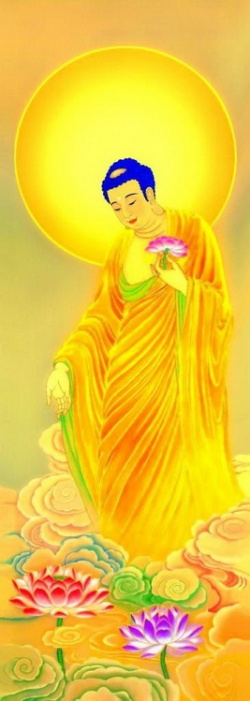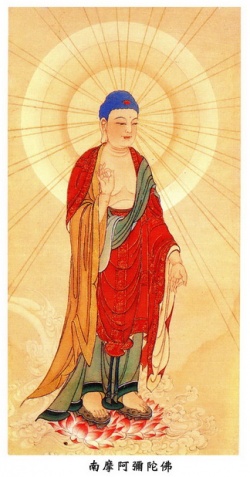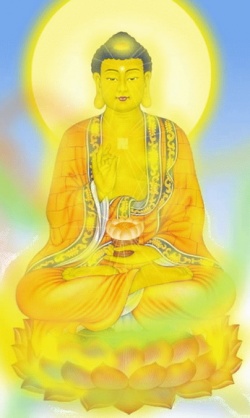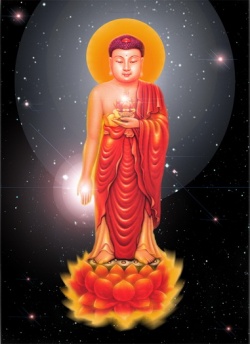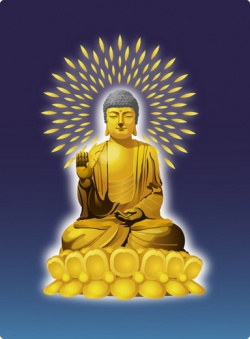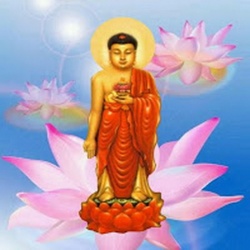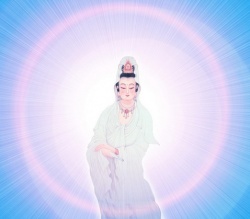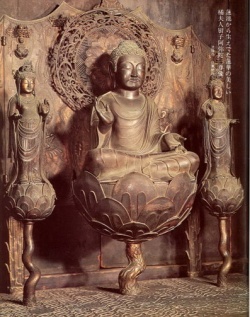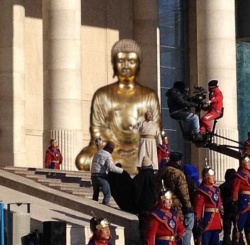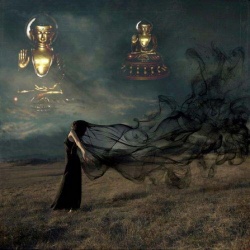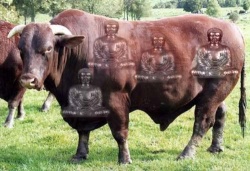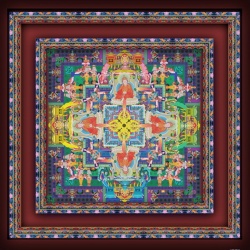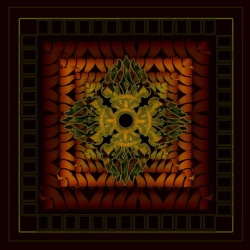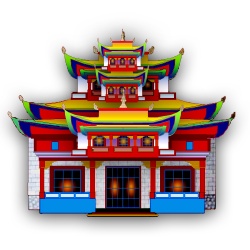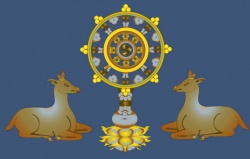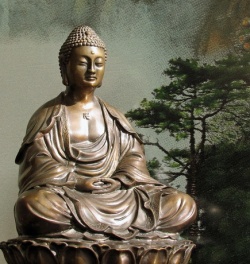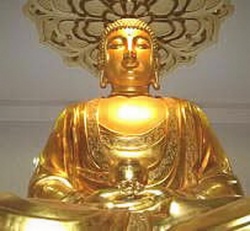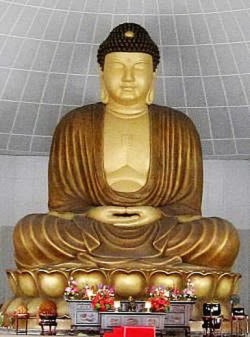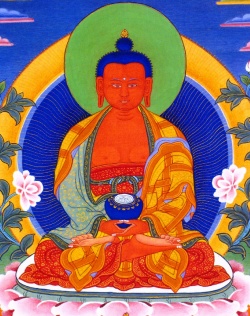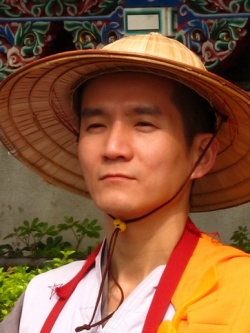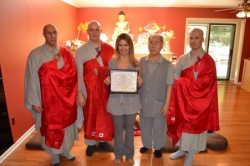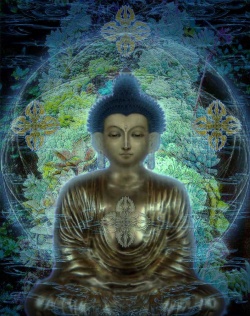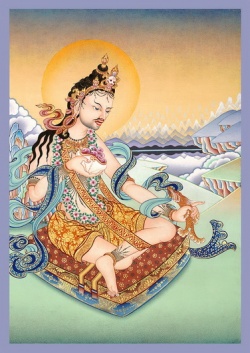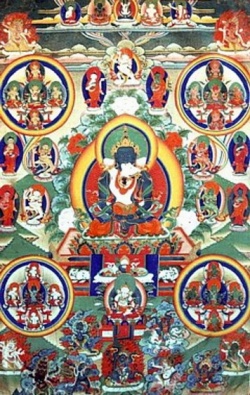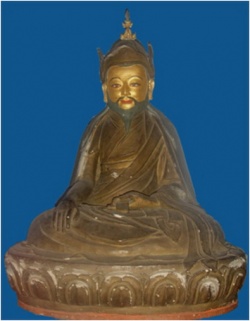Amitabha
Click here to see other articles relating to word Amitabha
Chinese: 阿彌陀佛, Ēmítuó Fó or Āmítuó Fó
Japanese: 阿弥陀如来, Amida Nyorai
Tibetan: Wöpakme
Vietnamese: A Di Đà Như Lai
Amitābha (Sanskrit: अमिताभ, Amitābha (wordstem), Sanskrit pronunciation: [əmɪˈt̪aːbʱə]) is a celestial Buddha described in the scriptures of the Mahāyāna school of Buddhism.
Amitābha is the principal Buddha in the Pure land sect, a branch of Buddhism practiced mainly in East Asia, while in Vajrayana Amitābha is known for his longevity attribute and the aggregate of distinguishing (recognition) and the deep awareness of individualities.
According to these scriptures, Amitābha possesses infinite merits resulting from good deeds over countless past lives as a Bodhisattva named Dharmakāra. "Amitābha" is translatable as "Infinite Light," hence Amitābha is often called "The Buddha of Infinite Light."
Doctrine
According to the Larger Sūtra of Immeasurable Life (Mahāyāna Amitāyus Sūtra) Amitābha was, in very ancient times and possibly in another system of worlds, a Monk named Dharmakāra. In some versions of the Sūtra, Dharmakāra is described as a former king who, having come into contact with the Buddhist teachings through The Buddha Lokesvararaja, renounced his throne.
He then resolved to become a Buddha and so to come into possession of a Buddhakṣetra ("Buddha-field", a realm existing in the primordial universe outside of ordinary space time, produced by a Buddha's merit) possessed of many perfections.
These resolutions were expressed in his forty-eight vows, which set out the type of Buddha-field Dharmakāra aspired to create, the conditions under which beings might be born into that world, and what kind of beings they would be when reborn there.
In the versions of the Sutra widely known in China, Vietnam, Korea and Japan, Dharmakāra's eighteenth vow was that any being in any universe desiring to be born into Amitābha's Pure land and calling upon his name even as few as ten times will be guaranteed Rebirth there.
His nineteenth vow promises that he, together with his bodhisattvas and other blessed Buddhists, will appear before those who call upon him at the moment of Death.
This openness and acceptance of all kinds of people has made the Pure land belief one of the major influences in Mahāyāna Buddhism. Pure Land Buddhism seems to have first become popular in northwest India/Pakistan and Afghanistan, from where it spread to Central Asia and China.
The Sutra goes on to explain that Amitābha, after accumulating great merit over countless lives, finally achieved Buddhahood and is still residing in his land of Sukhāvatī, whose many virtues and joys are described.
The basic doctrines concerning Amitābha and his vows are found in three canonical Mahāyāna texts:
Through his efforts, Amitābha created the "Pure land" (净土, Chinese: jìngtŭ; Japanese: jōdo; Vietnamese: tịnh độ) called Sukhāvatī (Sanskrit: "possessing Happiness") .
Sukhāvatī is situated in the uttermost west, beyond the bounds of our own world.
By the Power of his vows, Amitābha has made it possible for all who call upon him to be reborn into this land, there to undergo instruction by him in the Dharma and ultimately become bodhisattvas and Buddhas in their turn (the ultimate goal of Mahāyāna Buddhism).
From there, these same bodhisattvas and Buddhas return to our world to help yet more people.
Amitābha is The Buddha of the comprehensive Love.
He lives in the west (represented as a meditating Buddha) and works for the enlightenment of all beings (represented as a Blessing Buddha).
His most important Enlightenment technique is the visualization of the surrounding world as a paradise.
Who sees his world as a paradise, awakens his Enlightenment energy.
The world can be seen as a paradise by a corresponding positive thought (Enlightenment thought) or by sending Light to all beings (wish all beings to be happy).
After the Amitabha Doctrine, one can come to paradise (in the Pure land of Amitābha), if they visualize at their Death Amitābha in the Heaven (sun) over their head (western horizon), think his name as a Mantra and leave the Body as a soul through the crown chakra.
Vajrayāna Buddhism
Amitābha is also known in Tibet, Mongolia, and other regions where Tibetan Buddhism is practiced.
In the Highest Yoga Tantra class of the Tibetan Vajrayana Amitābha is considered one of the Five Dhyāni Buddhas (together with Akṣobhya, Amoghasiddhi, Ratnasambhava, and Vairocana), who is associated with the western direction and the Skandha of saṃjñā, the aggregate of distinguishing (recognition) and the deep awareness of individualities.
His consort is Pāṇḍaravāsinī.
His realm is called either Sukhāvatī (Sanskrit) or Dewachen (Tibetan).
His two main disciples (just as the Buddha Shakyamuni had two) are the Bodhisattvas Vajrapani and Avalokiteshvara, the former to his left and the latter to his right.
In Tibetan Buddhism, there exists a number of famous prayers for taking Rebirth in Sukhāvatī (Dewachen).
One of these was written by Je Tsongkhapa on the request of Manjushri,
The Tibetan Panchen Lamas and Shamarpas are considered to be emanations of Amitābha.
He is frequently invoked in Tibet either as Buddha Amitābha – especially in the Phowa practices or as Amitāyus – especially in practices relating to longevity and preventing an untimely Death.
In Japanese Vajrayāna, or Shingon Buddhism, Amitābha is seen as one of the thirteen Buddhist deities to whom practitioners can pay homage.
Shingon, like Tibetan Buddhism, also uses special devotional mantras for Amitābha, though the mantras used differ.
Amitābha is also one of the Buddhas featured in the Womb Realm Mandala used in Shingon practices, and sits to the west, which is where the Pure land of Amitābha is said to dwell.
Mantras
Amitābha is the center of a number of mantras in Buddhist Vajrayana practices. The Sanskrit form of the Mantra of Amitābha is ॐ अमिताभ ह्रीः (Devanagari: oṃ Amitābha hrīḥ), which is pronounced in its Tibetan version as Om ami dewa Hri (Sanskrit: oṃ amideva hrīḥ).
The Japanese Shingon Buddhist Mantra is On amirita teizei kara un which represents the underlying Indic form oṃ amṛta-teje hara hūṃ.
In addition to using the mantras listed above, many Buddhist schools invoke Amitābha's name in a practice known as nianfo 念佛 in Chinese and Nembutsu in Japanese.
Names in various languages
The proper form (wordstem) of Amitābha's name in Sanskrit is Amitābha, masculine, and the nominative singular is Amitābha.
This is a compound of the Sanskrit words amita ("without bound, infinite") and ābhā ("Light, splendor"). Consequently, the name is to be interpreted as "he who possesses Light without bound, he whose splendor is infinite".
The name Amitāyus (nominative form Amitāyuḥ) is also used for the Sambhogakāya aspect of Amitabha, particularly associated with longevity.
He is mostly depicted sitting and holding in his hands a vessel containing the nectar of immortality.
Amitayus is also one of the three deities of long Life (Amitayus, White Tara & Ushnishavijaya) . Amitāyus being a compound of amita ("infinite") and āyus ("Life"), and so means "he whose Life is boundless".
In Chinese, his name is given as Āmítuó Fó (阿彌陀佛), where Āmítuó is the Chinese representation of the first three syllables of either Amitābha or Amitāyus, and Fó is Chinese for Buddha (a very early borrowing of the first syllable of the Sanskrit word).
The name Amitābha is given in Chinese as Wúliàngguāng (無量光; "Infinite Light "), while the name Amitāyus is given as Wúliàngshòu (無量壽; "Infinite Life").
These names are not, however, very commonly used.
In Vietnamese, Korean, and Japanese, the same Chinese characters used for Amitabha are used to represent his name, though they are pronounced slightly differently:
In Japanese, he is also called Amida Nyorai (阿弥陀如来), meaning " the Tathāgata Amitābha".
In Tibetan, Amitābha is called 'od.dpag.med and, as Amitāyus, tshe.dpag.med.
Iconography
This altar display at a temple in Taiwan shows Amitābha in the center, flanked by Mahāsthāmaprāpta on The Buddha's left and Guānyīn on the right
It can be difficult to distinguish Amitābha from Śākyamuni (and any Buddhas in general) as both are portrayed as possessing all the attributes of a Buddha but no distinguishing marks.
Amitabha can, however, often be distinguished by his mudrā:
Amitābha is often depicted, when shown seated, displaying the meditation mudrā (thumbs touching and fingers together (as in the Kamakura statue of Amitābha) or the exposition mudrā, while the earth-touching mudrā (right hand pointed downward over the right leg, palm inward) is reserved for a seated Śākyamuni alone.
He can also be seen holding a Lotus in his hands while displaying the meditation mudrā.
There is a difference between Amitayus and Amitabha, (in Tibetan Buddhism) Amitayus~The Buddha of Infinite Life and Amitabha~ The Buddha of Infinite Light are essentially identical, being reflective images of one another.
Sutras in which Shakyamuni expounds the glories of Sukhavati, the Pure Lands, speak of the presiding Buddha sometimes as Amitabha and sometimes as Amitayus.
When depicted as Amitayus he is depicted in fine Clothes and jewels and as Amitabha in simple Monk's clothing.
They are also simply known as Amida in the Chinese and Japanese tradition.
The image of the gold colored statue in the article is of Amitayus as he is wearing a 5 pointed crown, which is the easiest way to distinguish them. Amitayus is an emanation of Amitabha.
Amitabha is the head of the Lotus family, where as Amitayus is not the head of the Lotus Family.
When standing, Amitābha is often shown with left arm bare and extended downward with thumb and forefinger touching, with the right hand facing outward also with thumb and forefinger touching.
The meaning of this mudra is that Wisdom (symbolized by the raised hand) is accessible to even the lowest beings, while the outstretched hand shows that Amitabha's Compassion is directed at the lowest beings, who cannot save themselves.
When not depicted alone, Amitābha is often portrayed with two assistants: Avalokiteśvara on the right and Mahāsthāmaprāpta on the left.
In Vajrayana, Amitābha is the most ancient Buddha among the Dhyani Buddhas.
He is of red color originating from the red seed syllable hrih. He represents the cosmic element of "Sanjana" (name).
He exhibits Samadhi Mudra his two palms folded face up, one on top of the other, lying on his lap.
The Lotus is his sign.
When represented on the Stupa, he always faces toward west.
He is worshiped thinking that one can have salvation.
Sometimes he holds a Patra on the same posture.
Within Mahayana Buddhism, Avalokiteśvara is not one consistent Gender.
In Shin Buddhism, the Bodhisattva is called "Kannon" and in Chinese Buddhism, the name "Guānyīn" is given to the same Bodhisattva, who changes genders depending on interpretation and imagery.
This Bodhisattva has been depicted as a man and a woman; some porcelain or jade statuettes or figurines visibly have breasts and feminine facial features while others have a flat male chest.
The common idea behind this is that the Bodhisattva transcends categories of Gender, as Buddhism in a whole tries to defy categorical and logical thinking that demands definitions in its entirety.
Archeological origins
The first known epigraphic evidence for Amitābha is the bottom part of a statue found in Govindnagar, Pakistan and now located at the Mathura Museum.
The statue is dated to "the 28th year of the reign of Huviṣka" (i.e., sometime in the latter half of the 2nd century CE, during the period of the Kuṣāṇa Empire), and was apparently dedicated to "Amitābha Buddha" by a family of merchants.
The first known Sutra mentioning Amitābha is the translation into Chinese of the Pratyutpanna Sūtra by the Kuṣāṇa Monk Lokakṣema around 180 CE.
This work is said to be at the origin of Pure land practice in China.
The appearance of such literature and sculptural remains at the end of the 2nd century suggests that the Doctrine of Amitābha probably developed during the 1st and 2nd centuries CE.
Furthermore, there are sculptures of Amitabha in Dhyani Mudras as well as bronzes of Amitabha in Abhaya Mudra from the Gandhara era of the 1st century CE suggesting the popularity of Amitabha during that time.
One of the last prayer busts of Amitabha can be found in the trademark black stone of the Pala Empire which was the last Buddhist empire of India and lost its influence in the 12th century due to Islamic invasions.
Source
Amitabha (Skt. Amitābha; Tib. འོད་དཔག་མེད་, Öpamé or སྣང་བ་མཐའ་ཡས་, Nangwa Tayé; Wyl. snang ba mtha' yas) — the Buddha of Boundless Light, belonging to the lotus family (one of the five buddha families).
The Amitabhavyuha Sutra tells us that many aeons ago, as the monk Dharmakara, he generated bodhichitta in the presence of the Buddha Lokeshvara.
At that time, he made fifty-one vows to lead all beings to his pure realm of Sukhavati.
On a deeper level, as Sogyal Rinpoche says, Amitabha "represents our pure nature and symbolizes the transmutation of desire, the predominant emotion of the human realm.
More intrinsically, Amitabha is the limitless, luminous nature of our mind."
See Also
Source
Amitabha is the most commonly used name for the Buddha of Infinite Light and Infinite Life.
A transhistorical Buddha venerated by all Mahayana schools (Tien Tai, Esoteric, Zen ...) and, particularly, Pure Land.
Presides over the Western Pure Land (Land of Ultimate Bliss), where anyone can be reborn through utterly sincere recitation of His name, particularly at the time of death.
Amitabha Buddha at the highest or noumenon level represents the True Mind, the Self Nature common to the Buddhas and sentient beings - all encompassing and all inclusive.
This deeper understanding provides the rationale for the harmonization of Zen and Pure Land, two of the most popular schools of Mahayana Buddhism. "Buddha Reatation," "Mind," "Pure Land."
"infinite light". Celestial buddha who, while a bodhisattva, vowed to lead all beings to the Pure Land.
Amida is the focus of devotion in Pure Land Buddhism and one of several revered buddhas of the Mahayana tradition.
Sanskrit word, literally means boundless light and boundless life.
He is the Buddha in the Land of Ultimate Bliss (Pure Land), in which all beings enjoy unbounded happiness.
Amitabha has forty eight great vows to establish and adorn his Pure Land.
People also recite or call upon his name by the time of dying will be born in the Land of Ultimate Bliss with the reception by Amitabha. Amitabha is one of the most popular and well known Buddha in China.
Buddha having unlimited light. Amitayus Buddha having unlimited life.
AMITABHA (Skt., "Infinite Light"= Tib. Opame) Buddha described in Mahayana sutras and held to dwell in a celestial paradise in the West)]. See BUDDHA.
The Buddha of Infinite Light. Creator of the Pure Land or Western Paradise, a place where beings can strive toward enlightenment free from the pain and suffering associated with life on earth. Chinese: A mi to po ("ah mee TOH poh"); Sanskrit: Amitabha ("ah mee TAH bah").
Amitabha (Chinese: A mi to po; Japanese: Amida), Budda of "Infinite Light" or "Infinite Life," is one of the five transcendental Buddhas. He is believed to reside over Western Paradise where souls of his followers strive for enlightenment.
Amitabha, The Gentle and Lovable Buddha (Tib. Opame): One of The Five Meditating Buddhas Amitabha is undoubtedly the most well known and popular of the five Dhyani Buddhas. He is red in color.
In Tibetan Buddhism, red is the color of love, compassion, and emotional energy.
It is in this direction that sunset takes place and indeed he is envisioned as the setting sun (red).
During sunset, the sun is gentle, and we can directly look into its fierce power, without coming to any harm.
As it disappears into the west, the sun is like a proud and fierce king, who at the end of a hard day of rigid protocol turns gentle and jovial, and allows anyone to approach him.
Amitabha is thus the supreme power and energy of nature, cast on an earthly plain, accessible to all of us. No wonder he is the most popular of all Dhyani Buddhas.
His unique emblem is the lotus.
He is thus associated with all the attributes of the lotus:
gentleness,
openness, and
purity.
Amitabha s mount is the peacock, which is capable of swallowing poisonous snakes without coming to harm.
In fact, the peacock is believed to derive its rich plumage from the poison of the snakes on which it feeds.
This symbolism, of being open even to poison, and transmuting it into beauty, gives us a feeling of the purifying and transforming power of Amitabha.
For us ordinary mortals, it signifies that even our darkest and most venomous aspects can be transformed by meditating on his image.
Amitabhas image has both a simplicity and archetypal quality to it. His demeanor is totally relaxed and his hands are in the Dhyana mudra, the mudra of meditation.
According to tradition, this mudra derives from the one assumed by the Buddha when he was meditating under the pipal tree, in the pursuit of Nirvana.
In conformity with his hand mudra, the essential message of Amitabha is that of meditation.
His association with the setting sun suggests the withdrawal of our external sense perceptions inwards, into higher states of meditative concentration.
Elevating ourselves to such a spiritual level has the ultimate objective of uniting us with that intangible Universal Consciousness which pervades all tangible reality.
Amitabha thus provides us with the archetypal infinite wisdom that helps us transmute the negative trait of obsessive attachment into a discerning awareness that we are all made up of the same primitive substratum.
So contemplating, we are able to realize that the object we crave for is not separate from us, and already as much a part of ourselves as we are of it.
The manifestation of the aggregate of discrimination of all Buddhas. He has a red coloured body.
A Buddha who increases our lifespan, merit, and wisdom. He is the Enjoyment Body aspect of Buddha Amitabha.
Amitabha is the most commonly used name for the Buddha of Infinite Light and Infinite Life.
A transhistorical Buddha venerated by all Mahayana schools (Tien Tai, Esoteric, Zen ...) and, particularly, Pure Land.
Presides over the Western Pure Land (Land of Ultimate Bliss), where anyone can be reborn through utterly sincere recitation of His name, particularly at the time of death.
Amitabha Buddha at the highest or noumenon level represents the True Mind, the Self Nature common to the Buddhas and sentient beings -- all encompassing and all inclusive.
This deeper understanding provides the rationale for the harmonization of Zen and Pure Land, two of the most popular schools of Mahayana Buddhism. See also "Buddha Reatation," "Mind," "Pure Land."
Amitabha is a celestial buddha described in the scriptures of the Mahayana school of Buddhism. Amitabha is the principal buddha in the Pure Land sect, a branch of Buddhism practiced mainly in East Asia.
According to these scriptures, Amitabha possesses infinite merits resulting from good deeds over countless past lives as a bodhisattva named Dharmakara.
"Amitabha" is translatable as "Infinite Light," hence Amitabha is often called "The Buddha of Infinite Light."
He is the Buddha of Unlimited Light and rules over the Western paradise of Sukhavati.
Legends say that a monk wished to attain Buddha hood and for this purpose he made 48 vows.
This monk, after a number of lifetime practice, became Buddha Amitabha. He is generally regarded either an object of meditation or embodiment of passion.
1. Amita - One of the two chief women disciples of Padumuttara Buddha (Bu.xi.25; J.i.37; SA.ii.68; DA.ii.489).
2. Amita - One of the two daughters of Sihahanu (the other being Pamita) and therefore a sister of Suddhodana, the Buddhas father.
She married Suppabuddha the Sakiyan and had two children, Bhaddakaccana and Devadatta.
She was a grand daughter of Devadaha Sakka (Mhv.ii.16-22; see Rockhill, p.13, where her son is called Kalyanavardhana).
She is the paternal aunt of the Buddha, referred to as being the mother of Tissa Thera (v.l. Amata). ThagA.i.105; MA.i.289.
-- or --
A king of twenty five kappas ago; a previous birth of Aggapupphiya Thera (v.l. Amitobhava, Amitogata). Ap.i.229.
-- or --
A king of twenty five kappas ago; a previous birth of Ekasannaka Thera. Ap.i.210.
Sanskrit; Amida (Japanese); one of the major buddhas of Mayahana school; he created a Pure Land free from suffering in which one can attain rebirth by calling out his name.
mythical Buddha of the Pure Land.
West, red, padma (lotus) family, passion and discriminating awareness, governs the present age.
One of the 5 Transcendent Buddhas;
Amitabha is the transcendent Buddha of the Western Pure Land.” Amitabha rules over this period of time.
Amitābha (also Amita), Skt. (Jap., Amida), lit., “Boundless Light”; one of the most important and popular buddhas of the Mahāyāna, unknown in early Buddhism.
He is ruler of the western paradise Sukhāvati, which is not to be understood as a location but as a state of consciousness. Amitābha is at the center of the worship of the Pure Land school of Chinese and Japanese Buddhism. He symbolizes mercy and wisdom.
Source
The name of the bodhisattva who established the Pure Land form of Buddhism.
The power he gained from his merit as a bodhisattva enabled him to establish the Pure Land and now allows him to help others enter the Pure Land.
The laity in particular can now enter the Pure Land with Amitabhas help, they do not have to get there on their own power. All they need do is to chant and believe the Amida Butsu.
In Mahayana, the Buddha of the Western Paradise (the Pure Land). Also encountered in the aspect of Amitayus (or Amitayus), Limitless Life. Pure Land Buddhists practice recitation of the name of Amitabha.
The name of the bodhisattva who established the Pure Land form of Buddhism. The power he gained from his merit as a bodhisattva allows him to help get to the Pure Land. They do not have to get there on their own power.
Source
Amitābha. (T. ’Od dpag med/Snang ba mtha’ yas; C. Amituo fo/Wuliangguang fo; J. Amida butsu/Muryōkō butsu; K. Amit’a pul/Muryanggwang pul 阿彌陀佛/無量光佛).
In Sanskrit, “Limitless Light,” the buddha of the western Pure Land of Sukhāvatī, one of the most widely worshipped buddhas in the Mahāyāna traditions.
As recounted in the longer Sukhāvatīvyūhasūtra, numerous eons ago, a monk named Dharmākara vowed before the buddha Lokeśvararāja to follow the Bodhisattva path to buddhahood, asking him to set forth the qualities of buddha-fields (Buddhakṣetra).
Dharmākara then spent five Kalpas in meditation, concentrating all of the qualities of all buddha-fields into a single buddha field that he would create upon his enlightenment.
He then reappeared before Lokeśvararāja and made forty-eight specific vows (Praṇidhāna).
Among the most famous were his vow that those who, for as few as ten times over the course of their life, resolved to be reborn in his buddha-field would be reborn there; and his vow that he would appear at the deathbed of anyone who heard his name and remembered it with trust.
Dharmakāra then completed the bodhisattva path, thus fulfilling all the vows he had made, and became the buddha Amitābha in the buddha-field called sukhāvatī.
Based on the larger and shorter versions of the Sukhāvatīvyūhasūtra as well as the apocryphal Guan Wuliangshou Jing (*Amitāyurdhyānasūtra), rebirth in Amitābha’s buddha-field became the goal of widespread Buddhist practice in India, East Asia, and Tibet, with the phrase “Homage to Amitābha Buddha”
(C. namo Amituo fo; J. Namu Amidabutsu; K. namu Amit’a pul) being a central element of East Asian Buddhist practice. Amitābha’s Indian origins are obscure, and it has been suggested that his antecedents lie in Persian Zoroastrianism, where symbolism of light and darkness abounds.
His worship dates back at least as far as the early centuries of the Common Era, as attested by the fact that the initial Chinese translation of the Sukhāvatīvyūhasūtra is made in the mid-second century CE, and he is listed in the Saddharmapuṇḍarīkasūtra (“Lotus Sūtra”) as the ninth son of the Buddha Mahābhijñā Jñānābhibhu.
The Chinese pilgrims Faxian and Xuanzang make no mention of him by name in their accounts of their travels to India in the fifth and seventh centuries CE, respectively, though they do include descriptions of deities who seem certain to have been Amitābha.
Scriptures relating to Amitābha reached Japan in the seventh century, but he did not become a popular religious figure until some three hundred years later, when his worship played a major role in finally transforming what had been previously seen as an elite and foreign tradition into a populist religion.
In East Asia, the cult of Amitābha eventually became so widespread that it transcended sectarian distinction, and Amitābha became the most popular buddha in the region.
In Tibet, Amitābha worship dates to the early propagation of Buddhism in that country in the eighth century, although it never became as prevalent as in East Asia.
In the sixteenth century, the fifth Dalai Lama gave the title Paṇ Chen Lama to his teacher, Blo Bzang Chos Kyi Rgyal Mtshan , and declared him to be an incarnation of Amitābha (the Dalai Lama himself having been declared the incarnation of Avalokiteśvara, Amitābha’s emanation).
The names “Amitābha” and “Amitāyus” are often interchangeable, both deriving from the Sanskrit word “amita,” meaning “limitless,” “boundless,” or “infinite”;
there are some intimations that Amita may actually have been the original name of this buddha, as evidenced, for example, by the fact that the Chinese transcription Amituo [alt. Emituo] transcribes the root word amita, not the two longer forms of the name.
The distinction between the two names is preserved in the Chinese translations “Wuliangguang” (“Infinite Light”) for Amitābha and Wuliangshou (“Infinite Life”) for Amitāyus, neither of which is used as often as the transcription Amituo.
Both Amitābha and Amitāyus serve as epithets of the same buddha in the longer Sukhāvatīvyūhasūtra and the Guan Wuliangshou jing, two of the earliest and most important of the sūtras relating to his cult.
In Tibet, his two alternate names were simply translated: ’Od dpag med (“Infinite Light”) and Tshe dpag med (“Infinite Life”).
Despite the fact that the two names originally refer to the same deity, they have developed distinctions in ritual function and iconography, and Amitāyus is now considered a separate form of Amitābha rather than just a synonym for him.
Amitābha is almost universally shown in Dhyānāsana, his hands at his lap in Dhyānamudrā, though there are many variations, such as standing or displaying the Vitarkamudrā or Varadamudrā.
As one of the Pañcatathāgata, Amitābha is the buddha of the padma family and is situated in the west.
In tantric depictions he is usually red in color and is shown in union with his consort Pāndarā, and in East Asia he is commonly accompanied by his attendants Avalokiteśvara (Ch. Guanyin) and Mahāsthāmaprāpta.
See also Jingtu Sansheng; Wangsheng.
Source
The Princeton Dictionary of Buddhism by Robert E. Buswell Jr. and Donald S. Lopez Jr.
Amitabha (snang ba mtha' yas). The chief buddha of the lotus family and lord of the pure land Sukhavati. He is also the manifestation of discriminating wisdom.
Articles containing word "Amitabha" in title
- 18th Vow of Amitabha Buddha
- 3 Practices for Bonding with Amitabha
- 48 Vows of Amitabha
- A Practice of Consciousness Transference Involving Amitabha
- A Short Sadhana of Amitabha Practice
- A Vision of Amitabha
- A Visualization for Singing the Mantra of Amitabha
- About the Mandala of Buddha Amitabha
- Alan Watts on Amitabha Buddha's Vow (Video)
- Amida
- Amida"s
- Amida's
- Amida's Pure Land
- Amida's Twelve Lights
- Amida's land
- Amida's life-span
- Amida's light
- Amida's vow
- Amida, the Dharma-body
- Amida-butsu
- Amida-kyo
- Amida-shu
- Amida Buddha
- Amida Buddha's
- Amida Buddha's Land
- Amida Buddha's Pure Land
- Amida Buddha's Pure Land of Perfect Bliss
- Amida Buddha's compassion
- Amida Buddha's light or wisdom
- Amida Buddha and the Ideal of Universal Salvation
- Amida Buddha in Modern Japan
- Amida Butsu
- Amida Dharani Sutra
- Amida Kyo
- Amida Mandala Buddhist Temple – Pureland Buddhism in the ...
- Amida Nyorai
- Amida Nyorai Konpon Darani
- Amida Nyorai’s
- Amida Shu – a Pureland Buddhist community
- Amida Sutra
- Amida Trust - Engaged Pureland Buddhism
- Amida and the Pure Land
- Amida butsu
- Amida ji
- Amida sutras
- Amida the Infinite
- Amidabutsu
- Amidabutsu Setsurin
- Amidakyo
- Amidakyo shaku
- Amidakyoshaku
- Amidas
- Amida’s
- Amit'a (Amitabha) with Six Bodhisattvas and Two Arhats
- Amitabha's
- Amitabha's Country
- Amitabha's Doctrine
- Amitabha's Iconography
- Amitabha's Pure Land
- Amitabha's pure land
- Amitabha's pureland
- Amitabha, Amitābha, Amitābhā, Amita-abha: 20 definitions
- Amitabha, Buddha of Boundless Light
- Amitabha, the Buddha of the Western Pure Land (Sukhavati
- Amitabha-Sadhana English
- Amitabha/Amitayus Buddha
- Amitabha/See Also Section
- Amitabha (Sk.) Amida (Jap.)
- Amitabha (Skt. Amitābha; Tib. འོད་དཔག་མེད་, Öpamé or སྣང་བ་མཐའ་ཡས་, Nangwa Tayé; སྣང་བ་མཐའ་ཡས་, Wyl. snang ba mtha' yas
- Amitabha - Buddha of Limitless Light
- Amitabha - Encyclopedia.com
- Amitabha Buddha
- Amitabha Buddha's
- Amitabha Buddha's Land of Ultimate Bliss
- Amitabha Buddha's vows
- Amitabha Buddha & His Pure Land: Why They Really Exist (A Must Watch) (Video)
- Amitabha Buddha - 2
- Amitabha Buddha Day
- Amitabha Buddha Personal Deity Yoga
- Amitabha Buddha Root Dharani
- Amitabha Buddha Sutra
- Amitabha Buddha Sutra & The Heart Sutra
- Amitabha Buddha and the Pureland of Dewachen
- Amitabha Buddha attained enlightenment ten eons ago
- Amitabha Buddha deity sadhana with guided meditation
- Amitabha Buddha mantra
- Amitabha Buddha of Infinite Light: what’s in a name?
- Amitabha Buddha resides in the Western region
- Amitabha Buddha’s
- Amitabha Buddha’s Twelve Kinds of Light: A Brief Explication
- Amitabha Buddhist Association of NSW
- Amitabha Buddhist Association of Queensland
- Amitabha Buddhist Retreat Centre
- Amitabha Buddhist Retreat Centre Newsletter: Australia
- Amitabha Buddhist Society
- Amitabha Buddhist Society (India)
- Amitabha Cult in India
- Amitabha Dhyani Buddha
- Amitabha Mantra
- Amitabha Mantras
- Amitabha Mudra
- Amitabha Origins
- Amitabha Phowa
- Amitabha Root Mudra
- Amitabha Sadhana
- Amitabha Sadhana Tibetan
- Amitabha Sadhana and Visualization Aid
- Amitabha Short Sadhana
- Amitabha Sutra
- Amitabha Sutra: cutting delusions with one-pointed blissful contemplation of Amitabha Buddha and the Pure Land
- Amitabha Sutra also enables one to attain Buddhahood
- Amitabha Thangka Karma Gadri style
- Amitabha Thrice Attentive Chanting Service
- Amitabha Triple Contemplation Service
- Amitabha Unification Sadhana
- Amitabha a story of Buddhist Theology by Paul Carus
- Amitabha and Amitayus
- Amitabha and Sûkhavati
- Amitabha and his Paradise
- Amitabha and the Lotus
- Amitabha by Alexander Berzin
- Amitabha in Nagarjuna and Vasubandhu
- Amitabha in Sukhavati
- Amitabha in the Lotus Sutra and in the Awakening of Faith
- Amitabha mantra
- Amitabha names in various languages
- Amitabha practice: Aspiration prayer
- Amitabha practice: Chanting and visualization
- Amitabha practice: Mantra recitation and visualization
- Amitabha practice: Prayer for the time of death, part 1
- Amitabha practice: Prayer for the time of death, part 2
- Amitabha practice across traditions
- Amitabha prayer
- Amitabha purifcation visualization
- Amitabha sadhana
- Amitabha sutra
- Amitabhas
- Amitabhavyuha Sutra
- Amitabha’s
- Amitabha’s pure land
- Approaching the Land of Bliss: Religious Praxis in the Cult of Amitabha (review
- Bhutamidam Sutta
- Brief Amitabha Mönlam
- Buddha Amida
- Buddha Amitabha
- Buddha Amitabha's nature
- Buddha Amitabha. Dewachen (Sukhavati) Prayer for Rebirth in Pure Land (Video)
- Buddha Amitabha 10 Levels
- Buddha Amitabha Sutra
- Buddha Amitabha and Bardo
- Buddha Amitabha’s
- Buddha Amitayus/Amitabha
- Buddha Amitayus/amitabha
- Buddha Expounding Amitabha Sutra
- Buddha Speaks of Amitabha Buddha Sutra
- Buddha Speaks of Amitabha Sutra
- Buddha Speaks of Amitabha SutraTruth. The merit and virtue from such cultivation adorns that land
- Buddha Speaks of Amitabha sutra
- Buddha Speaks of the Amitabha Sutra
- Buddha Speaks the Amitabha Sutra
- Buddha Spoke the Amitabha Sutra (Phật Thuyết A Di Đà Kinh)
- Buddha amitayus/amitabha
- Buddhist Paradise of Buddha Amitabha
- Can Rebirth in the Pure Land Be Attained by Reciting the Names of Buddhas Other than Amitabha? (Part Thre
- Chanting of Amida Buddha's name
- Connecting with Amitabha Buddha
- Consort of Amitabha
- Contemplation of Amida and the two bodhisattvas
- Contemplation of Amida himself
- Contemplation of the image of Amida
- Definitely Attain Buddhahood in the Land of Amitabha
- Depiction of Amitabha and Sukhāvatī
- Druk Amitabha
- Druk Amitabha Mountain
- Emanation of Amitabha
- Emanation of Buddha Amitabha
- Encyclopedia of Amitabha Buddha
- Essence of the Infinite Life Sutra - Amitabha Gallery
- Everything We Do Matters - Amitabha Buddhist Retreat Centre
- Forty-eight vows of Amitabha Buddha
- Full-Text of Amitabha Sutra
- Functions of the Tape of Five-variation Chanting of Amitabha
- Gaining Buddhahood Through Amitabha-Recitation Is the Teaching of the Buddhas
- God and Amida Buddha
- Guru Padmasambhava; From the heart of Buddha Amitabha
- Hail, Amitabha Buddha
- Heart Mantra of Amitabha Buddha
- Holy Day of Amitabha Buddha (阿彌陀佛聖誕 Amituofo Shengdan)
- Homa Ritual Honoring Amitabha Buddha
- Homage to Amida Buddha
- How to Teach Youngsters the Chanting of Amitabha
- How to visualize Amitabha at the time of death
- I pray to the protector Amitabha, the Buddha of limitless light
- I take refuge in Amida Buddha
- Iconography of Amitabha
- In One Lifetime - Pure Land Buddhism - Amitabha Buddhist Retreat
- In his commentary on the Amitabha Sutra, Patriarch Ou-I wrote:
- Incarnation of Amitabha
- Incarnation of Amitabha Buddha
- Instructions on the Amitabha Sadhana
- Introduction to the Amitabha practice
- Japanese Amida Buddha
- KADAMPA TEACHINGS - Amitabha Buddhist Centre
- Ksitigarbha Would Like You to Chant Amitabha-Ksitigarbha lebih senang Anda melafalkan Amitabha 净空法师 (Video)
- Lama Zopa Rinpoche blessing birds and ants at Buddha Amitabha Pure Land in Aug 2014 (Video)
- Land of Amida Buddha
- Larger Amitabha Sutra
- Larger Sutra on Amida Buddha
- Life and Light, the Infinite: A Historical and Philological Analysis of the Amida Cult
- Longer Amitabha Sutra
- Magnetize me: working with the magnetizing activity deities of the Padma Buddha family: Amitabha, Chenrezig, Hayagriva, Vajrayogini, Vajradharma
- Mantra of Buddha Amitabha - Head of The Padma (Lotus Family)
- Master Shandao’s Explanation of Amitabha’s 18th Vow in the Infinite Life Sutra
- Mikaeri Amida (Amitabha looking back)
- Namo Amida Buddha
- Namo Amitabha Buddha
- Namu-amida-butsu
- Namu Amida Butsu
- Nature of the Buddha Amitabha
- Nen'amidabutsu
- Nien Fo Book: The service book of the Amida Order
- Om Amitabha Hrih
- Om Amitabha Hrih!
- On Chanting "Amitabha" Dr. Yutang Lin
- On Chanting Amitabha
- On The Short Sadhana of Amitabha Buddha and The Pureland of Dewachen
- Origin of Amitabha Buddha?
- Overview of the Amitabha Buddha sadhana
- Paradise of Amitabha
- Practice of Amitabha
- Practicing the methods to take rebirth in the Pure Land of Buddha Amitabha according to the Sutras and Tantras
- Praise To Amitabha Buddha
- Prayer to be reborn in Amitabha’s pure land: verses 1-5
- Prayers to Amida Buddha, "Nembutsu", Serve as Our Anchor in Life by Hossu Tsuboi Shunei (Chief Priest of Main Temple Konkai-Komyo-ji in Kyoto)
- Profound simplicity of “Amituofo”: why Nianfo or Nembutsu is a deep, complete practice with innumerable benefits and cannot be dismissed as faith-based: w. full Amitabha Sutra
- Puja to Amitabha
- Pure Land of Amitabha
- Pure Land of Amitabha Buddha
- Pure land of Amitabha
- Pure land of Amitabha Buddha
- Pure land of Buddha Amitabha
- Rebirth mantra of Amitabha Buddha
- Reborn in the Pureland of Amitabha Buddha
- Reuniting with Infinite Light: Master Huijing’s "What Kind of Buddha Is Amitabha?"
- SN 12.31 Bhutamidam Sutta
- Sadhana of Amitabha
- Sadhana of Buddha Amitabha, Tarchin Hearn,
- Seated Amitabha Buddha (Amida Nyorai)
- Second Tibetan emanation of Amitabha Buddha
- Shakti of Amitabha
- Shakyamuni Buddha spoke the Amitabha Sutra
- Shorter Amitabha Sutra
- Silk - Virtues Amitabha
- Small Amitabha Sutra
- Sukhavati pure realm of Buddha Amitabha
- Sutra of Amida
- Take refuge in the Buddha Amitabha
- Tan Luan's Doctrine of Amitabha
- Tathagata Buddhas by the artist Zanabazar (1635-1723): Ratnasambhava, Amitabha, Amoghasiddhi, Vairochana
- The 48 Great Vows that Dharmakara Bodhisattva made before he ascended to Buddhahood as Amida Buddha
- The Active Aspect of Chanting Amitabha
- The Alaya (storehouse) consciousness and faith in Amida Buddha
- The Amida Sutra
- The Amida Sutra:Translations & Commentaries
- The Amitabha Buddhist Society of U.S.A.
- The Amitabha Root Dharani
- The Amitabha Sutra
- The Amitabha Sutra As Discoursed By The Buddha
- The Amitabha Sutra and the Pure Land School
- The Benefits of Amitabha-Recitation In Our Present and Future Lives
- The Benefits of Reciting Amitabha's Name Every Day - FPMT
- The Buddha's Expounding of the Amitabha Sutra
- The Buddha Amitabha with the Eight Great Bodhisattvas
- The Buddha Speaks of Amitabha Buddha Sutra Part 1
- The Buddha Speaks of Amitabha Buddha Sutra Part 2
- The Buddha Speaks of Amitabha Buddha Sutra Part 3
- The Buddha Speaks of Amitabha Buddha Sutra Part 4
- The Buddha Speaks of Amitabha Buddha Sutra Part 5
- The Buddha Speaks of Amitabha Buddha Sutra is generally known as the (Small) Amitabha Sutra.
- The Buddha Speaks of Amitabha Sutra
- The Buddha Speaks of Amitabha Sutra - Based on the Chinese text translated by Tripitaka Master Kumarajiva of Yao Qin
- The Buddha Speaks of Amitabha Sutra with Commentary by the Venerable Master Hsuan Hua
- The Buddhist Practice of Chanting Amitabha
- The Different Levels of Amitabha Practice
- The Gospel of Buddha:Chapter 60: Amitabha
- The Independent Action of “Namo Amitabha”
- The Inscription on the Kusan Image - of Amitabha and and the Character of Early Mahayana in India
- The Jade Turtle Records 碧龜記: Amitabha Buddha
- The Method of Contemplation on Amida
- The Mudra Of Amitabha Buddha In Japanese sculpture and iconography
- The Recitation of Amitabha’s Mantras
- The Sadhana of Buddha Amitabha
- The Sadhana of Buddha Amitabha II
- The Shingon Subordinating Fire Offering for Amitābha, “Amida Kei Ai Goma”
- The Shorter Sukhavati Sutra (Sukhavati-Vyuha Sutra or Amitabha Sutra)
- The Smaller Sutra On Amida Buddha
- The Three Pledges Relating to the Buddha Amitabha
- The Twelve Adorations of Amida Buddha by Bodhisattva Nāgārjuna
- Twelve Adorations of Amida Buddha
- Understanding Amitabha Buddha Sutra from the Perspective of the Lotus Sutra
- Unification of Mind and Wind - A wonderful method of chanting Amitabha
- Vaidehi wishes to be born in Amida's Pure Land
- Vase of Longevity (Kalasha) with Buddha Amitabha
- Visualize Amida Buddha
- Vow of Amitabha
- We should follow Master Shandao in interpreting Amitabha’s 18th Vow
- What Kind of Buddha Is Amitabha? - Pure Land Buddhism
- What do you think: why is this Buddha called Amitabha?
- What does quantum physics have to do with the Five Buddhas — Vairochana, Amitabha, Akshobya, Ratnasambhava, and Amoghasiddhi?
- What’s so special about Hayagriva? This wrathful Heruka emanation of Amitabha
- Who is Amida?
- Who is Amitabha, the Limitless?
- Who is Amitabha?
- Why recite the name of Amitabha?
- Worshipping Amida Buddha - Liturgies and Ceremonies of Amidaji Temple
- Wrathful Amitabha
- Wrathful Emanation of Buddha Amitabha
- Wrathful emanation of Amida Nyorai
- Śuddha-Amidaba-Avalokita
